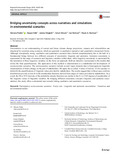JavaScript is disabled for your browser. Some features of this site may not work without it.
| dc.contributor.author | Pedde, Simona | |
| dc.contributor.author | Kok, Kasper | |
| dc.contributor.author | Onigkeit, Janina | |
| dc.contributor.author | Brown, Calum | |
| dc.contributor.author | Holman, Ian P. | |
| dc.contributor.author | Harrison, Paula A. | |
| dc.date.accessioned | 2018-06-18T15:05:11Z | |
| dc.date.available | 2018-06-18T15:05:11Z | |
| dc.date.issued | 2018-05-11 | |
| dc.identifier.citation | Simona Pedde, Kasper Kok, Janina Onigkeit, et al., (2019) Bridging uncertainty concepts across narratives and simulations in environmental scenarios. Regional Environmental Change, March 2019, Volume 19, Issue 3, pp. 655–666 | en_UK |
| dc.identifier.issn | 1436-3798 | |
| dc.identifier.uri | https://doi.org/10.1007/s10113-018-1338-2 | |
| dc.identifier.uri | http://dspace.lib.cranfield.ac.uk/handle/1826/13239 | |
| dc.description.abstract | Uncertainties in our understanding of current and future climate change projections, impacts and vulnerabilities are structured by scientists using scenarios, which are generally in qualitative (narrative) and quantitative (numerical) forms. Although conceptually strong, qualitative and quantitative scenarios have limited complementarity due to the lack of a fundamental bridge between two different concepts of uncertainty: linguistic and epistemic. Epistemic uncertainty is represented by the range of scenarios and linguistic variables within them, while linguistic uncertainty is represented by the translation of those linguistic variables via the fuzzy set approach. Both are therefore incorporated in the models that utilise the final quantifications. The application of this method is demonstrated in a stakeholder-led development of socioeconomic scenarios. The socioeconomic scenarios include several vague elements due to heterogeneous linguistic interpretations of future change on the part of stakeholders. We apply the so-called ‘Centre of Gravity’ (CoG) operator to defuzzify the quantifications of linguistic values provided by stakeholders. The results suggest that, in these cases, uniform distributions provide a close fit to the membership functions derived from ranges of values provided by stakeholders. As a result, the 90 or 95% intervals of the probability density functions are similar to the 0.1 or 0.05 degrees of membership of the linguistic values of linguistic variables. By bridging different uncertainty concepts (linguistic and epistemic uncertainties), this study offers a substantial step towards linking qualitative and quantitative scenarios. | en_UK |
| dc.language.iso | en | en_UK |
| dc.rights | Attribution 4.0 International | * |
| dc.rights.uri | http://creativecommons.org/licenses/by/4.0/ | * |
| dc.subject | Participatory socioeconomic scenarios | en_UK |
| dc.subject | Fuzzy sets | en_UK |
| dc.subject | Linguistic and epistemic uncertainties | en_UK |
| dc.subject | Narratives and environmental models | en_UK |
| dc.title | Bridging uncertainty concepts across narratives and simulations in environmental scenarios | en_UK |
| dc.type | Article | en_UK |
Files in this item
The following license files are associated with this item:
This item appears in the following Collection(s)
-
Staff publications (SWEE) [2857]

